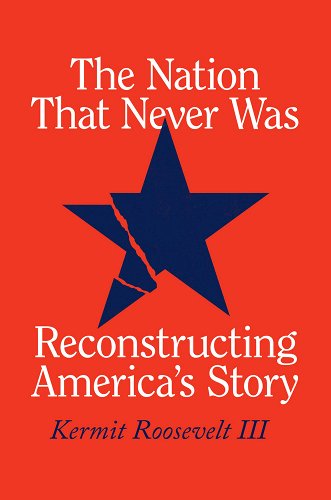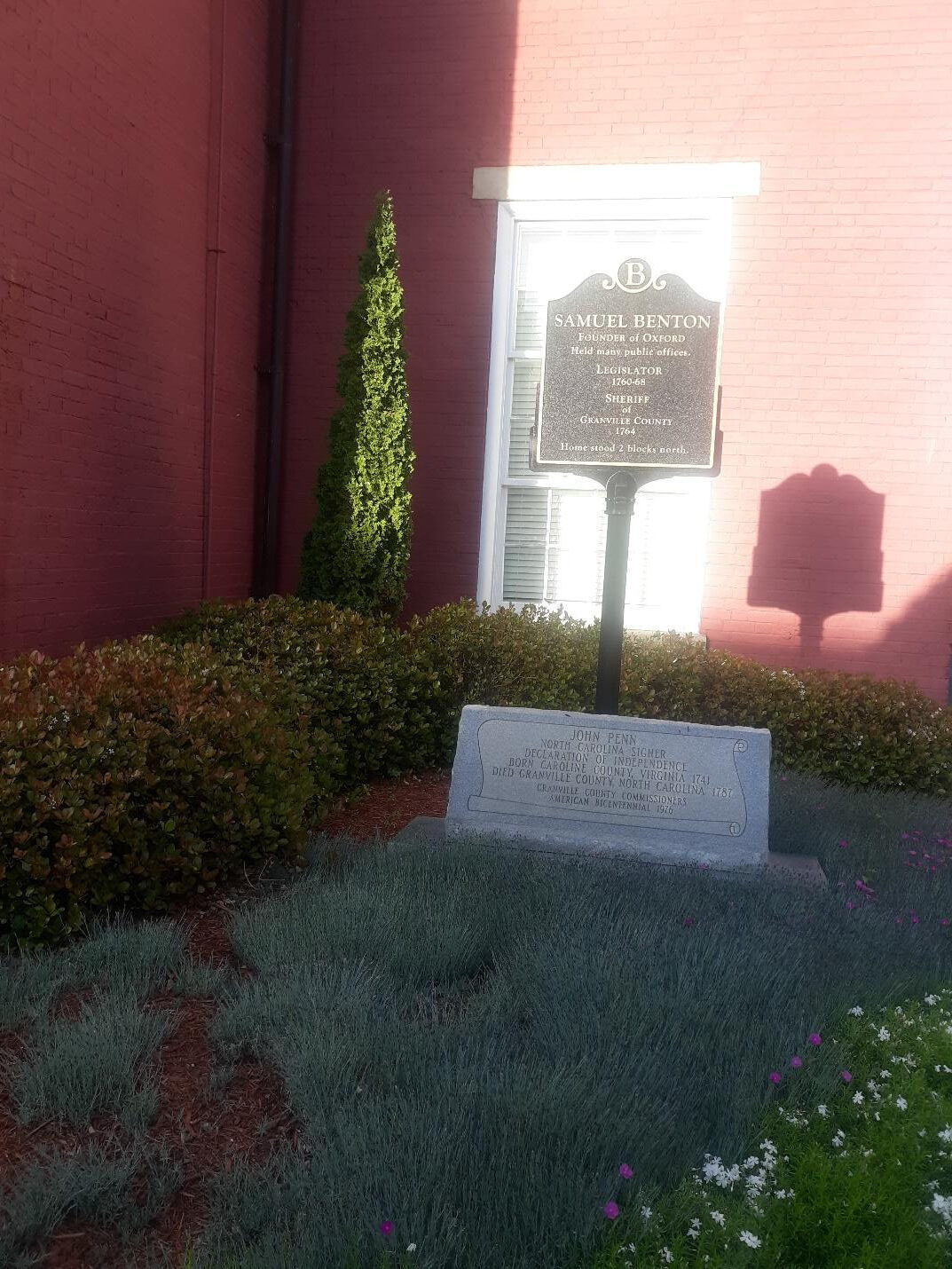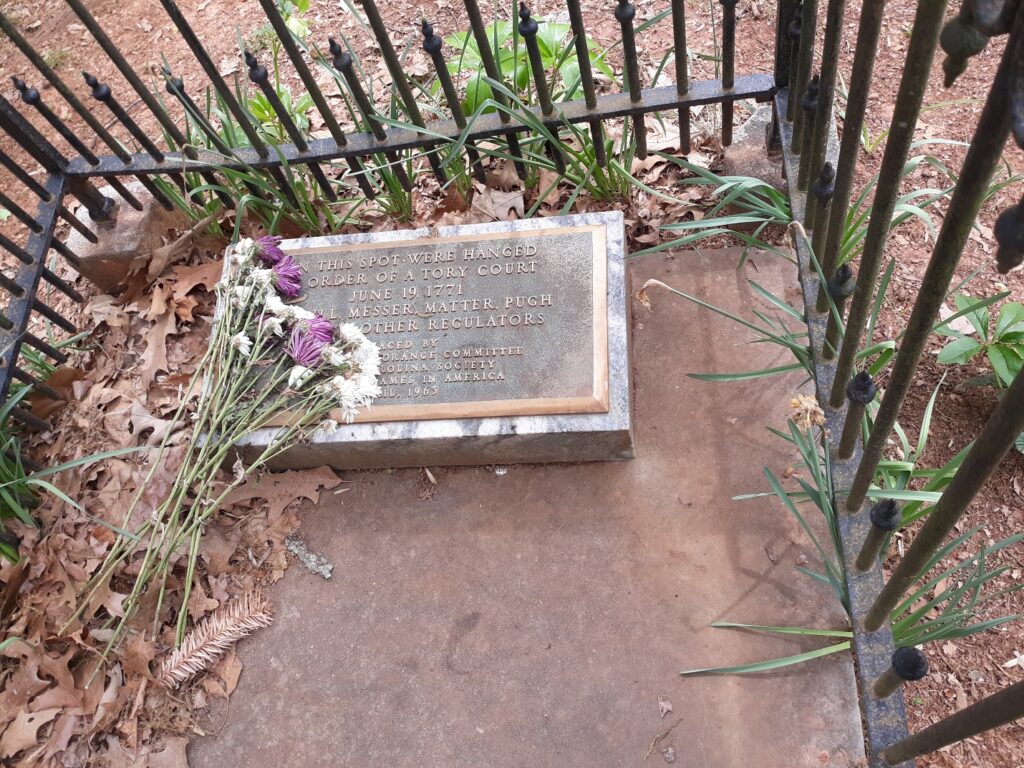Durham, NC. Granville Sharp was a clerk in the British Ordnance Board, responsible for supplying arms to the Redcoats. Or he was a clerk until the American Revolution broke out. Not willing to aid the military repression of the Americans, Sharp took several leaves of absence, hoping that the warring parties could work out terms of peace which respected American rights. When peace was not forthcoming, Sharp resigned from his secure job and turned to his brothers for support. His friendship with America included corresponding with the antislavery American patriot-physician Benjamin Rush.
Sharp was also a key founder of the British antislavery movement. He promoted the Somerset litigation, which led to the emancipation of slaves in England in 1771—the British colonies retained their slavery laws, but speculating that fears of the Somerset decision’s implications helped excite American opposition to Britain has been an amusing parlor game for many people recently. After the Revolution, Sharp was active in establishing a settlement in Sierra Leone in West Africa for Black veterans of the British army who had left their Patriot masters to fight for the king.
The story of Sharp quitting his job rather than help in the war effort against the American revolution isn’t in Kermit Roosevelt’s The Nation that Never Was. Unlike Sharp, Roosevelt, a constitutional law professor at the University of Pennsylvania Law School (and great-great grandson of Teddy Roosevelt) cannot reconcile support for the Revolution with opposition to slavery and racial oppression. Roosevelt’s thesis is that the achievements of the Founding era—the Declaration of Independence, the Revolution, and the Constitution—do not deserve honor or respect in modern America. To Roosevelt, the true founding of America is to be found by looking to Abraham Lincoln and the Reconstruction era.
It is not simply “triumphalist” narratives of the Founding which Roosevelt challenges. He also challenges the Old Testamentish accounts of the Founding as setting forth high ideals which the country repeatedly failed to live up to. Such was the import of Martin Luther King’s bounced-check metaphor in his famous speech at the March on Washington. It was also the theme of Abraham Lincoln, who warned before the Civil War that Revolutionary principles were being undermined by a Slave Power conspiracy, and who invoked the Founders in his wartime advocacy of a “new birth of freedom” leading to a reunited, slavery-free country.
Even the 1619 project, to Roosevelt, falls into the error of honoring at least part of the Founding—the Declaration of Independence. All such respect for the Founding must be swept away, avows Roosevelt: “Almost no modern scholars agree with me that the Declaration of Independence is consistent with slavery.”
But Roosevelt forges boldly forward in making his case against the Declaration, the Revolution and the Constitution. Lincoln and King were either duped (or trying to dupe others) in praising the Founding—the sordid reality is that the Founding era promoted an “exclusive individualism” of people rebelling merely to defend their own rights. It was Lincoln who founded the modern age of “inclusive equality” as an ideal. While Roosevelt acknowledges that many Founders were antislavery, these Founders put aside their views in order to accept unity among the Patriots—unity at the expense of justice for the slaves. This foreshadowed later instances of white Americans preferring unity to racial justice.
In Roosevelt’s telling, it is downright dangerous to appeal to the legacy of the Revolution—whether in the triumphalist America-is-great spirit or in an Old Testamentish spirit of warning a guilty nation that it has fallen short of its own ideals. The “exclusive individualism” of the Revolution leads to extreme laissez-faire economic policies, distrust of government “redistribution” of resources, an unwillingness to deal properly with racial injustice, and even encouragement of insurrection.
The standard narrative of the Revolution encourages people to “stop thinking about race,” Roosevelt argues. In fact, “you cannot take white supremacy out of the Founding, and plenty of people don’t want to. In embracing the Founding, we play into their hands.”
To Roosevelt, the true heirs to the American Revolution are the Confederates in the Civil War. And the true heirs of the Founders and the Confederates were Ronald Reagan and Donald Trump, whose terms in office are comparable to the political-terrorist overthrow of Reconstruction in the era of so-called “Redemption” in the 1870s.
Roosevelt offers an alternative founding narrative, one he thinks Americans can be genuinely proud of. This new narrative centers on the post-Civil-War vision of a racially egalitarian society (albeit with the sad omission of women’s rights). This is supposedly far superior to the Founding vision.
Quoting Karl Marx, Roosevelt claims that Lincoln’s Emancipation Proclamation represented the “tearing up of the old American Constitution.” Shifting to his own voice, Roosevelt adds that the Civil War and Reconstruction acted to “break the preexisting American order.” From Lincoln through to the 14th Amendment, the United States used military force to replace the insular and selfish principles of Founding America with a new—and often sadly unrealized—vision of egalitarian democracy and rights. Historical memory of the Founding should be discredited like the historical memory of the Confederacy to which it supposedly led.
Since the repudiation of the Confederacy has included tearing down its statues and changing names associated with the losers of the 1861-1865 rebellion, then one would think that the logical culmination of Roosevelt’s principles would be to destroy Revolutionary monuments and memorials too. Roosevelt doesn’t speak to this point, but it’s hard to avoid the logic of his argument.
Before taking a broad view of Roosevelt’s thesis, I’m going to look at some (not all) of the Revolutionary-era monuments in my neck of the woods—central North Carolina. If Roosevelt gets his way, it may be the last chance we have to check such monuments. These local memorials of events in the Founding era tell a more complicated story of its conflicts and aspirations.
The National Park Service runs the Guilford Courthouse National Military Park, which commemorates a key Revolutionary battle a bit to the west of me. The American victory here in 1781 paved the way for the British surrender in Yorktown several months later.
One of North Carolina’s signers of the Declaration of Independence was John Penn, whose monument at the old Oxford, NC courthouse was literally outshone, at the time I took the picture below, by the monument to Samuel Benton, founder of Oxford.
The memorial to the Halifax Resolves, supposedly the first state recommendation in favor of Independence, reflects some of the ambiguities in the relationship between the Revolution and slavery. The Halifax Resolves were adopted in Halifax County in the northeast of the state, and the memorial is in the State Capitol. The date of the resolves is on the state flag. Some state license plates, based in part on the Halifax Resolves, started boasting the slogan “First in Freedom,” which didn’t go over well with some Tar Heels who argued that their ancestors hadn’t been freed in 1776. (State licenses nowadays tend to say “First in Flight,” referring to the Wright Brothers.)
There is a memorial to British troops in the Revolution in Snow Hill, which may be considered a strange sort of honor for the victors over the British to bestow them. But the monument went up in 1941, when many Americans, officially and unofficially, supported the British in their war with Germany—a was the U. S. was soon to formally enter.
A similar spirit may have animated those who named Cornwallis Road, after the British General who fought the Battle of Guilford Courthouse on his way through North Carolina toward his encounter with destiny at Yorktown (or perhaps they were just grateful for some road repairs).
North Carolina memory links the Revolution with an earlier event, the Regulator rebellion. Small farmers fought the government elites who overtaxed them and then seized their land for tax delinquency. The insurgents were defeated at the Battle of Alamance in 1771, and six of them were hanged. A memorial to the hanging victims is in Hillsborough.
The connection between this event and the Revolution is not simple. Many former Regulators—once bitten, twice shy—joined the Tories rather than the rebels the next time around, while many of those who helped repress the regulators became Patriots. This complicates the public commemoration. Despite the complicated reality, there are two monuments on the Alamance battleground, from 1880 and 1901, commemorating the Battle of Alamance as the first shots in the Revolution (the 1880 monument portrays two interlocking images of cannons, so configured as to look suspiciously like a Confederate St. Andrews Cross).
I’ll end this tour of local monuments at the grave of someone who fought the British in the Regulator rebellion—where he narrowly escaped hanging—and later fought them in the Revolution, too. I attended the dedication of the gravesite memorial to James Emerson in Silver City.
Now let’s see whether, contra Roosevelt, the swirling complexities of the American Revolution have any redeeming features making it worth all this commemoration. My concern is that suppressing Revolutionary memory would encourage an oppressive, monolithic, faceless ”just so” story that violates personal and local realities. People—whether those who lived in the past or those alive today—rarely slot into sweeping, ideological narratives.
America “escape[d] the stale and oppressive monarchies of Europe,” to quote Professor Roosevelt himself. Professor Roosevelt does not specifically assign a cause for this happy development, but of course it comes from the American triumph in the Revolution.
To be clear, celebrating the Founders’ achievement does not mean saying the regime they set up was the best conceivable, or that it is invulnerable to criticism; see, e. g., the very interesting postliberal critique of the Revolution’s liberal premises. It is sufficient that most contemporaries and their descendants found the liberal regime resulting from the Revolution to be better than British colonial rule. The Hanoverian regime in Britain and her empire was also liberal, based on Parliamentary supremacy and corruption, an Erastian religious establishment, and an irresponsible and oppressive aristocracy. George III’s regime claimed the power to impose the statutes of the British Parliament on the colonies, even in strictly internal affairs, without regard for the colonists’ chartered liberties. The Patriot argument was that Englishmen in England, and British subjects in the colonies, enjoyed the same rights, including the recognized English right of being taxed only with the consent of a properly chosen representative body, which in the colonies meant the popular branch of the legislature. By trampling on this right, and other localism-protecting rights like trial by jury, the liberal Hanoverian establishment showed itself more oppressive than the liberal Patriots, and worthy of being replaced by the domestic regime the Patriots set up.
To Roosevelt’s point, the Hanoverian regime was also worse on slavery than the North American colonies. It is true that the British Army, once the Revolution broke out, often recruited the slaves of Patriots into the royal army. It’s a reflection on many Patriots that they had slaves for the British to recruit in the first place. But Hanoverian Britain was not the abolitionist Britain of a later generation—it was a slave empire whose “loyal” Caribbean colonies like Jamaica relied on importing African slaves through the Middle Passage. And though the Continental Congress sadly blocked Jefferson’s plan to unambiguously mention this fact in the Declaration of Independence, George III had in fact vetoed bills in many of the Patriot colonies against the African trade. These vetoes were certainly implicit in the Declaration’s accusation that King George “has refused his Assent to Laws, the most wholesome and necessary for the public good.” A more specific reference to the King’s slaving proclivities would have hit home, and the defeat of Jefferson’s version was a sad “own goal” (as the British might put it) on the part of the Patriots.
What about the higher ideals of the Revolution, the ideals which Lincoln and King believed in and which they said had been violated by later generations of faithless Americans?
As for as openness versus insularity, it’s worth noting that one of the Declaration’s accusations against King George was limitations on immigrant settlement and naturalization. Roosevelt would presumably counter this by mentioning that this settlement, promoted by the Patriots, was often at the expense of the indigenous peoples, but then, many of Roosevelt’s heroes of Reconstruction were also open to criticism on this point.
While Professor Roosevelt believes that the Declaration’s avowal that all men are created equal had no value in critiquing slavery or other evils, the proslavery Senator from South Carolina, John C. Calhoun, knew better. He was aware that the created-equal language endangered his project of defending slavery as a positive good which ought to be extended in its scope, specifically into American territories. In an 1848 speech, Calhoun took aim at the Massachusetts Constitution’s provision that “all men are born free and equal” (Massachusetts courts had freed the Bay State’s slaves based on this provision) and extended his criticism to the Declaration’s affirmation that all men are created equal. Jefferson’s “error,” Calhoun said, led the Declaration’s author to believe that blacks “were as fully entitled to both liberty and equality as” whites. This “error” was responsible for the antislavery provisions of the Northwest Ordinance, keeping slavery out of an extensive swath of American territory and providing a bad precedent for Calhoun, who believed there was a constitutional right of slave masters to take slaves into any federal territory.
In a famous speech in March 1861, Alexander Stephens, Vice-President of the newly formed Confederacy, said that the Confederate government’s “foundations are laid, its corner-stone rests, upon the great truth that the negro is not equal to the white man; that slavery subordination to the superior race is his natural and normal condition. This, our new government, is the first, in the history of the world, based upon this great physical, philosophical, and moral truth.” Emphasizing the latter point, Stephens said: “Many who hear me, perhaps, can recollect well, that this truth was not generally admitted, even within their day. The errors of the past generation still clung to many as late as twenty years ago.” Stephens waxed Biblical (see Psalm 118:22, Acts 4:11), saying of white supremacy and black subordination: “This stone which was rejected by the first builders ‘is become the chief of the corner’ the real ‘corner-stone’ in our new edifice.” The “first builders,” of course, were the Founders, upon whose work Stephens thought the Confederacy had improved.
From slavery’s supporters, then, we have these attestations that the Declaration of Independence had principles hostile to slavery. What about the Constitution? As Professor Roosevelt notes, the Constitution made three fairly specific concessions to slavery. Georgia and South Carolina were permitted to import Africans as slaves until 1808 (when a complete Congressional ban on slave imports took effect). Slave states could count three-fifths of their oppressed and voteless slaves for purposes of increasing their representation in the House of Representatives and the Electoral College. The advantage frequently affected election results, giving the South an increased power in the federal government. Naturally, the South used their extra power to promote proslavery policies. The slave states began to lose this advantage, of course, as the population of the North and West grew, until these areas of the country were able to impose a President—Lincoln—on a protesting South, leading to secession and war. But while it lasted, the three-fifths clause allowed the South to have great influence over the federal government, even at the expense of the Constitution itself.
This influence was illustrated in the highly expansive reading of the third explicit Congressional concession to slavery—a concession which soon swallowed up other constitutional provisions like a cancer devouring healthy organs. The fugitives-from-service clause, appallingly, actually provided for the return of slaves who had escaped into free states. This deplorable concession was not enough for the slavers, who insisted on abrogating jury rights for alleged fugitives, contrary to the Seventh Amendment, and denying them habeas corpus and a judicial hearing on their case.
What is more, although Professor Roosevelt acknowledges that the Constitution allowed free states to liberate slaves brought into their jurisdiction with the master’s consent, the Slave Power insisted on denying this liberty-affirming principle. In the case of Jane Johnson and Passmore Williamson, federal authorities tried to send a woman back into slavery after she had been brought into Pennsylvania with her master’s consent. In the Lemmon case from New York, the Slave Power aspired to get a decision from the U. S. Supreme Court that masters could hold their slaves in slavery even in a free state, so long as the masters were only “sojourning” in the free state. All this in violation of what Professor Roosevelt acknowledges to be the Constitution’s pro-freedom dictates.
With the Lemmon case we get back to Lincoln and his prewar warnings about a Slave Power conspiracy to nationalize slavery, contrary to the Constitution and the Declaration of Independence. In 1854, Lincoln foe Stephen Douglas had persuaded Congress to repeal the Missouri Compromise and open up large territories, especially Kansas, to slavery if the settlers approved. In 1857, the Supreme Court in the Dred Scott case said that masters could bring their slaves into the federal territories regardless of Congressional freedom legislation. Also, the Court denied that Black people, even free Black people, could be citizens. Lincoln warned that these developments were foretastes of an attempt to set aside the Declaration and Constitution, nationalize slavery, and introduce the institution even into free states, and the Lemmon case seemed to show Lincoln right (it was the outbreak of the Civil War which seems to have kept the Lemmon case off the U. S. Supreme Court’s docket).
Professor Roosevelt doesn’t try to defend the Dred Scott decision as correct; he simply blames the Founders for allowing a system in which the case could be so decided. But Lincoln had an explanation—the Slave Power was trying to snuff out the Declaration and Constitution. Roosevelt says what I hadn’t heard before—that black people were among the delegates in the conventions ratifying the Constitution in 1788. In any event, Justice Curtis’ dissent in Dred Scott shows that free Black people were voting in some states when the Constitution was adopted, refuting Taney’s claim that Black Americans could never be citizens. And we have seen how Calhoun had to disavow the Declaration in order to support the case for extending slavery into federal territories.
So Lincoln’s account seems more plausible: the Declaration and the Constitution showed an unwillingness on the part of the Founders to make slavery the norm; it was the Slave Power which wanted to do so in defiance of the Founders’ legacy. Without endorsing every detail of Lincoln’s conspiracy theory, his Old Tetamentish portrayal of a Slave Power conspiring against the Founding seems perfectly credible and aligns with a view of American history as populated by conflicted people fighting over core principles: the Founders were neither demons nor angels.
When Lincoln’s election deprived the South of its control over the federal government, Southern leaders adopted a rule-or-ruin attitude and began to wreck the country rather than let it go back to Founding principles. The Confederacy they formed was based, as we have seen, on the denial of the inspiring words of freedom in the Declaration of Independence. But since the Declaration of Independence was a declaration of secession from the British Empire, Roosevelt sees the Declaration as justifying the later Confederate secession. Yet the Declaration only justified secession if the central government was violating the rights of the seceders. This “compact theory” was invoked by the Confederates to justify breaking off from the American Union, but Roosevelt doesn’t comment on whether the North was in fact violating its obligations to the slave states. As it happens, you’d need Taney-tinted glasses to say that the North was violating its Constitutional obligations simply by seeking to enforce jury trial and habeas corpus for alleged fugitive slaves and for insisting on keeping slavery out of the territories. We don’t have to accept Lincoln’s categorical opposition to all secession to see that the Confederate secession had no basis in the compact theory which they invoked.
As George Orwell famously said: “Who controls the past controls the future. Who controls the present controls the past.” Cutting off the Founding, and denying what Lincoln and the Reconstruction supporters affirmed was the link between the Founding and the bloody recovery of American principles during the Civil War, can’t bring us anywhere good. Professor Roosevelt acknowledges that repudiating the Founding would mean purging the memory of Benjamin Franklin.
After excluding less plausible interpretations like Roosevelt’s, I think the Old Testamentish version of the Founding is the most defensible: the Founders left us some good principles which later were often disregarded, but which brave men and women in later eras fought for, often with success.
















I hope either Mr.Longley or FPR forwards this review to Mr.Roosevelt.
I would be interested in his response. On C-SPAN, I once saw him give a compelling lecture about re-imagining the Founding. He got a standing ovation.
“the Founders left us some good principles which later were often disregarded”
Well, gosh, there’s a strong full-throated support for America. “some good principles”?
“repudiating the Founding would mean purging the memory of Benjamin Franklin.”
I’m sorry, but the notion that a significant drawback of chucking the Founders in the garbage is the loss of reverence for Ben Franklin is just so deeply unserious. It’s not as if he was without massive personal flaws–womanizer, destroyed his family over politics, etc., etc. How can you keep him? Because he never owned slaves, due to being born in Boston rather than Virginia? How long do you think that line is going to hold against these Year Zero scumbags?
George Washington was among the most significant non-religious figures in all of history. His winning a revolution and then walking away from power is the most remarkable and important action of the past several centuries. This Kermit character and all his ilk aren’t fit to shine his shoes, and a nation that repudiates him is completely and totally without merit. Those who are trying to turn us into such a nation are vile and wretched villains.
Roosevelt’s take on this seems to be the inevitable outcome of the type of analysis that totally demonizes the South while basically baptizing the North. See Robert Penn Warren’s The Legacy of the Civil War. While the South’s “Great Alibi” is on its way out, the North’s “Treasury of Virtue” is certainly alive and well. This is what happens when the winners not only write the history books but limit the contemporary interpretation of that textus receptus. Modern liberal man will have his scapegoats, and if the American South won’t completely do the trick, the search must needs extend backwards. It’s much easier (and more self-affirming) to point to the past by toppling statues and destroying memorials than it is to look actual contemporary problems in the face.
Thanks for that, Rob.
Comments are closed.